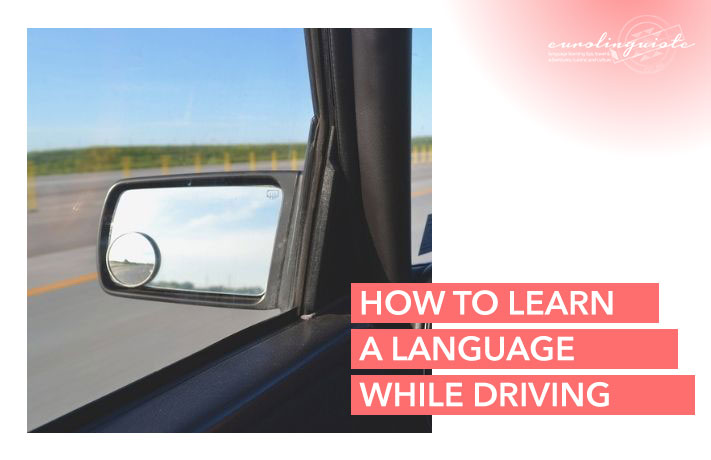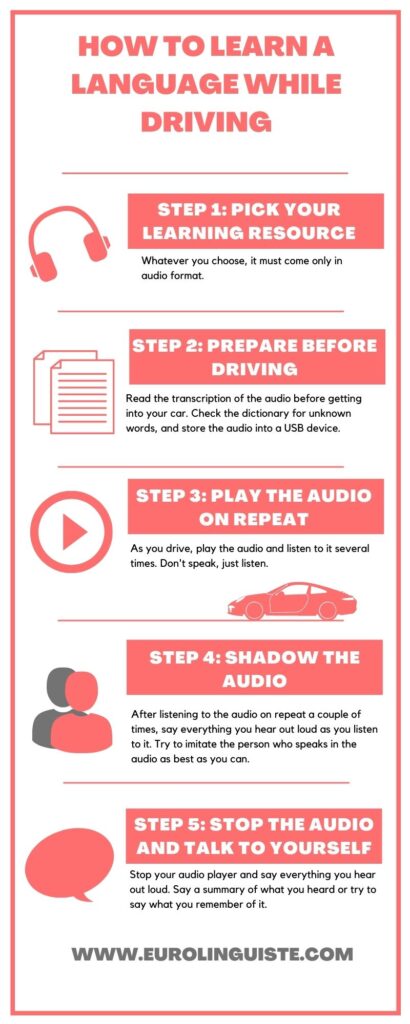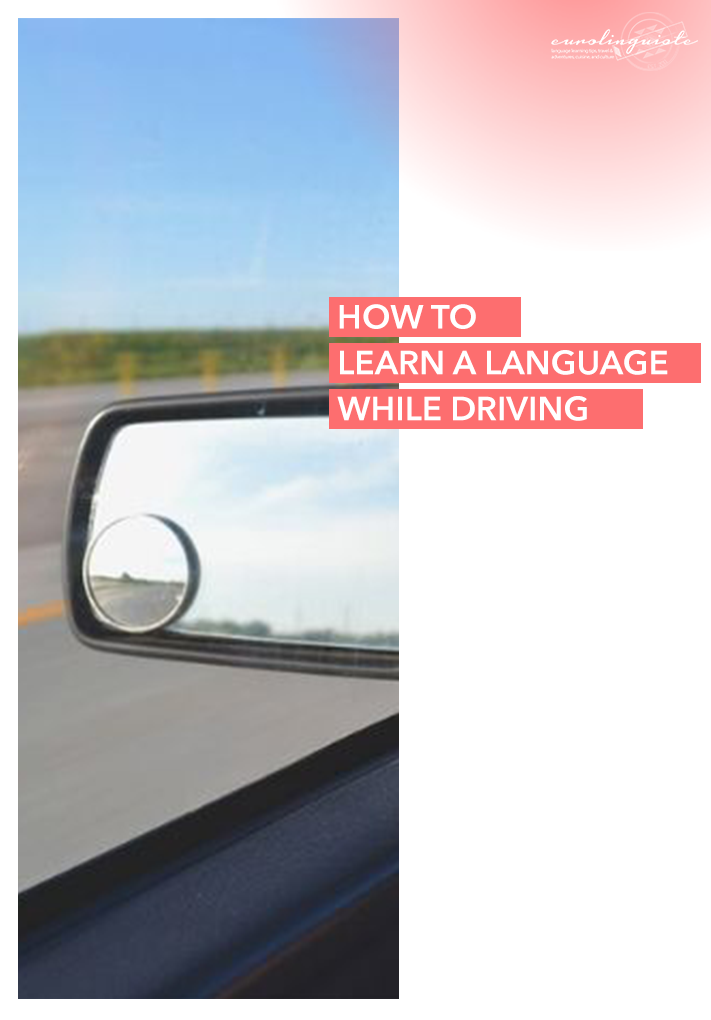How to Learn a Language While Driving

My name is Shannon Kennedy and I'm the language lover,…
Can you learn a language while driving?
No doubt. If you’re passionate about learning a language, you want to make the most out of your time in order to learn and improve your skills. Driving might be a great opportunity to do just that.
I remember when I was learning to speak English; I was obsessed with it. I wanted to be fluent, sound natural, and spontaneous, but there was something that was clear to me: If I wanted to achieve that, I had to go beyond my weekly lessons in the classroom. I needed to find time to keep getting that language into my head.
So, there I was, hiring an American guy to go with me on every single ride during my 2-hour commute so I could practice English and maximize my learning time. That’s how I learned to speak English.
“Are you serious?”
No, I’m just pulling your leg, I couldn’t have paid for that. Plus, I don’t think finding a native speaker to do that would’ve been an easy job.
However, I did learn a lot of English on the road, and in this article, you’ll learn to do what I did back then, so you can maximize your language learning time while driving.
After you read this blog post, you’ll be ready to hit the road and enhance your knowledge of a language at the same time. So, off we go!
Why Learning a Language While Driving Is a Good Idea
If you want to be fluent in any language, you have to understand something: weekly lessons and your textbook are not enough!
You need to make your target language part of your daily life. When I say your daily life, I mean that you have to:
- Hear it every day,
- Include it in your daily activities, and
- See it often.
In other words, you need to hang out with the language as much as you can, and in many countries driving opens up a big opportunity to spend a good amount of time learning a language.
For example, when I was learning English, I got a job for a company that had several store locations in the same city.
I had to visit each store almost every day and they were 40 minutes away from each other. So, if I had to visit 3 stores a day, then I would need to drive for 120 minutes (2 hours of driving every day).
It goes without saying that it was boring to be stuck in traffic.
My job was 6 days per week, and if I spent my time learning a language in the car, I would’ve gotten 12 hours of language learning a week without attending a classic class.
I’m not going to lie, I wasn’t learning English every single time I got into my car. I love listening to music while driving as well, but what I want you to realize is that if you take some time spent doing a passive activity like driving, you could boost the overall time you spend with your target language.
Just think about it: how much time are you spending behind the wheel every week? Could you invest some of that time working on that language you want to learn?
I’m sure you could, and you’ll be glad if you do.
What To Expect When You Learn a Language Behind the Wheel
Remember the guy I said I hired to practice English with while driving? No, you won’t get that. In fact, most of the time spent learning a language while driving will be through listening.
Why? Because I want you to drive safely. If any activity involves taking your sight off the road, that is very dangerous.
Because of that, when you get into your car to learn a language, you won’t and can’t:
- Use your language learning app to do the language review of the day,
- Call your language exchange partner,
- Have a textbook, obviously,
- Engage in grammar rules review, or
- Take any kind of written notes.
Yes, there are downsides for your reading and writing skills. Heck, even grammar might be mad at you because you’re ignoring it, but let it be mad.
It’s not that important anyway.
If you want to learn a language while driving, then you should place your focus exclusively on the following two activities:
- Listening
- Speaking
When Is It a Good Time to Learn a Language in Your Car?
Not all rides are suitable for language learning sessions. I learned this lesson when I offered to give my cousin a ride once. He was sick, and as soon as he got into the car he said: “I don’t want to talk, just take me to the hospital.”
I was okay with that, and since he didn’t feel like talking, I thought it was a good opportunity to play my English lessons. The funny thing was that after a couple of minutes of me listening to a story in English, my cousin began to ask questions:
“Do you understand everything you hear?”
“Are you planning on traveling, then?”
“Please don’t leave, who’ll take me to my medical appointments then?”
It was question after question, but he had said he didn’t want to talk!
The lesson? If you’re going somewhere with other people in the car, it might be a little frustrating when you’re trying to concentrate on your language lesson. So:
- Do it if driving alone.
- Put your windows up (I’ll tell you why later, just keep reading).
- Make sure you won’t need to use your eyes or hands for anything else than driving.
Also, keep in mind that stress is a big enemy to learning, so don’t do it if you’re in a rush.
5 Steps to Learning a Language While Driving
Now that you know learning a language while driving may bring a lot of benefits to your progress. It’s clear that, in your car, you’ll focus solely on…
- Listening
- And speaking.
And you already know when the appropriate times are for learning a language in the car. Now, you’ll find five steps for learning a language effectively as you drive:
Step 1: Pick Your Learning Resource Beforehand
The only learning material that you should use in your car should be in audio format, but don’t wait until the last minute to select your next listening resource. Plan ahead and be ready for when you need to hit the road.
Something you can do is to set aside a specific day to organize and store the audio you’ll use during the week.
Will you practice your Portuguese as you commute? Then why not organize your audio files on Sunday and select which audio you will use during each day of the week?
Some of the resources I used to listen to back in my English learning experience were:
- Audio stories,
- Audiobooks,
- Podcasts,
- Audio lessons, and
- Interviews.
It would be even better if whichever audio you choose comes with a transcription.
Why?… So you can go to Step 2.
Step 2: Prepare Yourself Before You Hit the Road
You’ll use the transcription, printed page, or the written version of whatever you’ll be hearing to read everything you’ll hear in the car before you get behind the wheel.
You shouldn’t wait until you’re in the car to read the transcription. Do it at home or your office, but don’t read as you drive.
This will be a great opportunity to get an idea of what the audio will be about, look up the meaning of new words in the dictionary, or take note of new phrases that the audio contains.
After doing that, I suggest you copy the audio files into a USB flash drive, so you can play them from it instead of your phone. I’ve had instances in which my phone would die as I was listening to an English audio, or a phone call would come in and I’d have to figure out a way to resume the audio after hanging up the call.
That might be dangerous. Plus, in most cars, the audio starts playing as soon as you plug in the device.
Step 3: Play the Audio & Repeat It Many Times.
Play the audio as you drive and take advantage of you not having to use your hands. A good way to do this is to play the audio on repeat many times.
Of course, that wouldn’t be very fun if you do so incessantly for a 2 hour drive, but make sure you don’t listen to the audio only once.
Repetition is a great way to internalize the new words and vocabulary you learn. Besides, it’ll give you time to pay close attention to how words are pronounced in your target language.
Step 4: Shadow the Audio.
This step was especially useful for me when I was learning to speak English. Since I was listening to short stories in my car, it was easier to follow and even memorize the stories by repeating them many times.
Shadowing meant that I was telling the story just as I heard in the audio, acting much like a parrot who repeats everything they hear.
You should do the same and repeat everything you hear. When I say “everything,” I mean literally everything:
- Imitate the pronunciation of the speaker you hear in the audio,
- Use the same intonation you hear, and
- Copy and exaggerate the pronunciation you hear.
Heck, yell the story as you shadow it. The higher your energy when you learn your target language, the more it will stick to you.
Back when I was learning, yelling the stories in my car was pretty fun (and liberating, haha!).
This is something experts use in NLP (Neuro Linguistic Programming): they connect ideas with high energy and positive emotions to make it stick in your brain. This is something you can do with your target language as well.
But won’t people think you’re crazy if they see you yelling in Chinese or French as you drive?
How To Avoid Other Drivers Thinking You’re Crazy
Remember when I told you to put your windows up? Yes, this is the reason why I told you to do that. We don’t want your voice to exit the car and call attention to you from other people.
Another thing you can do is to only speak when your car is moving.
Back when I was learning, every time I stopped at traffic lights, other drivers would look at me because I seemed to be talking and saying things to myself. The straw that broke the camel’s back was when I accidentally looked at the car next to me as I was repeating the story I was hearing. The driver said:
“What is it, buddy?”
That was a little uncomfortable, but I learned that I should shut my mouth every time I stopped at a traffic light.
Step 5: Stop the Audio Player
Whenever you feel ready, a good way to check your progress is to stop the audio player of your car and talk to yourself about whatever you just heard in your target language.
Don’t be afraid to have a conversation with yourself asking questions, or just form a quick summary about the audiobook, podcast episode, or interview you just heard.
Something I used to do when I listened to short stories was to retell the story myself, without having shadowed the audio. I came up with a couple of rhythms in my mind so I could sing the story and make it stick.
So, why not rap that short story you heard in your target language?
Conclusion
And there you go; this is how to learn a language while driving. To be honest, being behind the wheel was such a big advantage to me back when I was just starting my first language learning journey.
I’m sure you can get a lot out of it if you implement some of the ideas you just read. To wrap things up, we’ve seen the cons and pros of learning a language in your car in this article.
You also learned that if you’re going to do this, you need to be willing to engage only in listening and speaking, so that this doesn’t become a risky activity.
And finally, you learned how to do it in five steps:
- Pick your learning resource beforehand,
- Prepare before you hit the road,
- Play the audio & repeat it many times,
- Shadow the audio, and
- Stop the audio player.
The following inphographic summarizes all these steps, feel free to pin it or print it out. I’ll be useful to have these ideas in mind:

These recommendations are based on my experience, but I’m curious about yours.
Are there any other techniques to learn a language while driving that you’ve tried?
Let me know in the comments below.


About the Author:
Diego Cuadros is a blogger at Spanishtomind.com and a Spanish online teacher. He uses stories to help Spanish lovers understand fast-speaking native speakers, so they don’t freeze and panic in conversations.
My name is Shannon Kennedy and I'm the language lover, traveler, and foodie behind Eurolinguiste. I'm also the Head Coach of the Fluent in 3 Months Bootcamp, co-founder of Women in Language, and former Resident Polyglot at Drops.



